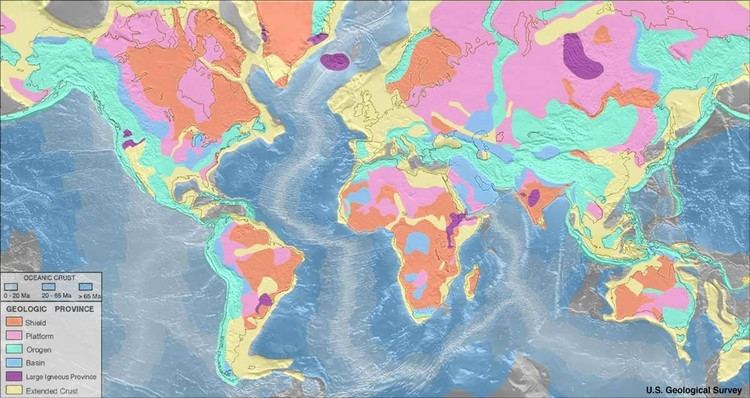 | ||
A shield is generally a large area of exposed Precambrian crystalline igneous and high-grade metamorphic rocks that form tectonically stable areas. In all cases, the age of these rocks is greater than 570 million years and sometimes dates back 2 to 3.5 billion years. They have been little affected by tectonic events following the end of the Precambrian, and are relatively flat regions where mountain building, faulting, and other tectonic processes are greatly diminished compared with the activity that occurs at the margins of the shields and the boundaries between tectonic plates.
The term shield, used to describe this type of geographic region, appears in the 1901 English translation of Eduard Suess's Face of Earth by H. B. C. Sollas, and comes from the shape "not unlike a flat shield" of the Canadian Shield which has an outline that "suggests the shape of the shields carried by soldiers in the days of hand-to-hand combat."
A shield is that part of the continental crust in which these usually Precambrian basement rocks crop out extensively at the surface. Shields themselves can be very complex: they consist of vast areas of granitic or granodioritic gneisses, usually of tonalitic composition, and they also contain belts of sedimentary rocks, often surrounded by low-grade volcano-sedimentary sequences, or greenstone belts. These rocks are frequently metamorphosed greenschist, amphibolite, and granulite facies.
Shields are normally the nucleus of continents and most are bordered by belts of folded Cambrian rocks. Because of their stability, erosion has flattened the topography of most of the continental shields; however, they commonly do have a very gently convex surface. They are also surrounded by a sediment-covered platform. By contrast, in a platform, the shield (more accurately referred to then as the crystalline "basement") is overlain by horizontal or subhorizontal sediment. Together, the shield, platform and basement are the parts that comprise the stable interior portion of the continental crust known as the craton.
The margins surrounding a shield generally constitute relatively mobile zones of intense tectonic or plate-like dynamic mechanisms. In these areas, complex sequences of mountain building (orogeny) events have been documented over the past few hundred million years.
For example, the Ural Mountains, to the west of the Angaran Shield, are atop the mobile zone that separates the shield from the Baltic Shield. Similarly, the Himalayas are on the mobile boundary between the Angaran and Indian shields. Shield margins have been subject to geotectonic forces that have both destroyed and rebuilt the margins and the cratons that they partially comprise. In fact, the growth of continents has occurred as a result of the accretion of younger rocks that underwent deformations during series of mountain building processes. In a sense, these belts of folded rocks have been welded onto the borders of the preexisting shields, thus increasing the size of the proto-continents that they make up.
Continental shields occur on all continents, for example:
